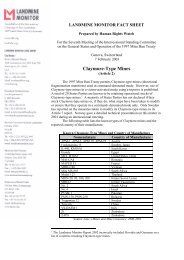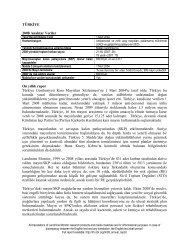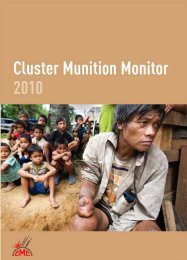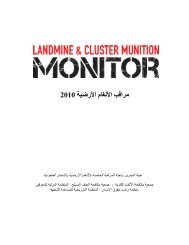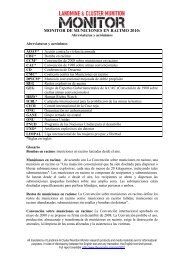Download PDF - Landmine and Cluster Munition Monitor
Download PDF - Landmine and Cluster Munition Monitor
Download PDF - Landmine and Cluster Munition Monitor
Create successful ePaper yourself
Turn your PDF publications into a flip-book with our unique Google optimized e-Paper software.
Casualties <strong>and</strong> Victim Assistance<br />
Region<br />
<strong>Cluster</strong> munition casualties by region<br />
Casualties during<br />
use of cluster<br />
munitions<br />
Casualties from<br />
cluster munition<br />
remnants<br />
Total confirmed<br />
casualties<br />
Total estimated<br />
casualties<br />
Asia 25 (unknown) 10,654 10,679 10,654–42,568<br />
Middle East <strong>and</strong> North Africa 417 3,527 3,944 6,449–8,949<br />
Europe, Caucasus, <strong>and</strong> Central<br />
Asia<br />
1,176 528 1,704 1,704<br />
Africa 479 344 823 823<br />
Americas 44 N/A 44 44<br />
Total 2,141 15,053 17,169 19,674–54,063<br />
The vast majority (15,053) of reported casualties occurred after cluster munition use <strong>and</strong> were caused by cluster<br />
munition remnants, including explosive submunitions, that failed to detonate during strikes. Data on casualties due to<br />
cluster munition strikes is more difficult to systematically collect <strong>and</strong> is often not included in casualty reporting. The other<br />
2,141 casualties were recorded from cluster munition strikes. The casualties at the time of use are grossly underreported;<br />
therefore the actual number of casualties, both known <strong>and</strong> estimated, is massively underrepresented. 8<br />
Civilian status<br />
In the cases where the status was recorded, civilians accounted for the majority (94%) of casualties (10,447), while<br />
humanitarian deminers (clearance personnel) accounted for 3% <strong>and</strong> security forces (military, police, <strong>and</strong> other security<br />
forces) accounted for another 3%. However, for 6,076 casualties (more than a third of all cluster munition casualties), the<br />
civilian status was not indicated or recorded. 9 See the following table <strong>and</strong> chart.<br />
Recorded cluster munition casualties:<br />
Civilian status<br />
Civilian 10,447 60.7%<br />
Deminer 361 2%<br />
Security Forces 310 1.8%<br />
Unknown 6,076 35%<br />
Total 17,194 100%<br />
Deminers<br />
3%<br />
Security<br />
forces<br />
3%<br />
Civilians<br />
94%<br />
Age status<br />
In cases where the age was known, the majority (60%) of recorded civilian casualties were adults aged 18 <strong>and</strong> above<br />
(9,708 casualties) <strong>and</strong> a significant proportion (40%) were children. The age was not recorded for 739 civilian casualties.<br />
See the following table <strong>and</strong> chart.<br />
Recorded civilian cluster munition<br />
casualties: Adults/children<br />
Adult 5,866 57%<br />
Child 3,842 37%<br />
Unknown 739 6%<br />
Total 10,447 100%<br />
Children<br />
40% Adults<br />
60%<br />
8<br />
See CMC, <strong>Cluster</strong> <strong>Munition</strong> <strong>Monitor</strong> 2011 (Ottawa: Mines Action Canada, October 2011), www.the-monitor.org/index.php/publications/<br />
displayurl=cmm/2011/CMM_Casualties_Victim_Assistance_2011.html. Globally, states have done little public reporting of military<br />
casualties from cluster munitions, even when they were likely to have been significant, such as in the 1991 Gulf War.<br />
9<br />
See also, Circle of Impact: The Fatal Footprint of <strong>Cluster</strong> <strong>Munition</strong>s on People <strong>and</strong> Communities (Brussels: HI, May 2007).<br />
53



